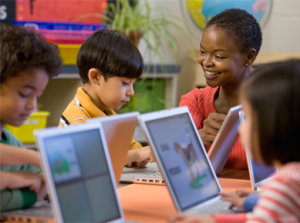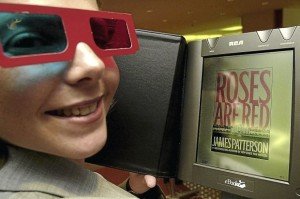Articles
DO E-BOOKS MAKE IT HARDER TO REMEMBER WHAT YOU JUST READ?
By Maia Szalavitz
Time – 3/14/2012
I received a Kindle for my birthday, and enjoying “light reading,” in addition to the dense science I read for work. I immediately loaded it with mysteries by my favorite authors. But I soon found that I had difficulty recalling the names of characters from chapter to chapter. At first, I attributed the lapses to a scary reality of getting older — but then I discovered that I didn’t have this problem when I read paperbacks.
When I discussed my quirky recall with friends and colleagues, I found out I wasn’t the only one who suffered from “e-book moments.” Online, I discovered that Google’s Larry Page himself had concerns about research showing that on-screen reading is measurably slower than reading on paper.
This seems like a particularly troubling trend for academia, where digital books are slowly overtaking the heavy tomes I used to lug around. On many levels, e-books seem like better alternatives to textbooks — they can be easily updated and many formats allow readers to interact with the material more, with quizzes, video, audio and other multimedia to reinforce lessons. But some studies suggest that there may be significant advantages in printed books if your goal is to remember what you read long-term.
Kate Garland, a lecturer in psychology at the University of Leicester in England, is one of the few scientists who has studied this question and reviewed the data. She found that when the exact same material is presented in both media, there is no measurable difference in student performance.
However, there are some subtle distinctions that favor print, which may matter in the long run. In one study involving psychology students, the medium did seem to matter. “We bombarded poor psychology students with economics that they didn’t know,” she says. Two differences emerged. First, more repetition was required with computer reading to impart the same information.
Second, the book readers seemed to digest the material more fully. Garland explains that when you recall something, you either “know” it and it just “comes to you” — without necessarily consciously recalling the context in which you learned it — or you “remember” it by cuing yourself about that context and then arriving at the answer. “Knowing” is better because you can recall the important facts faster and seemingly effortlessly.
“What we found was that people on paper started to ‘know’ the material more quickly over the passage of time,” says Garland. “It took longer and [required] more repeated testing to get into that knowing state [with the computer reading, but] eventually the people who did it on the computer caught up with the people who [were reading] on paper.”
Context and landmarks may actually be important to going from “remembering” to “knowing.” The more associations a particular memory can trigger, the more easily it tends to be recalled. Consequently, seemingly irrelevant factors like remembering whether you read something at the top or the bottom of page — or whether it was on the right or left hand side of a two-page spread or near a graphic — can help cement material in mind.
Why Remembering Names is Hard – and what to do about it
This seems irrelevant at first, but spatial context may be particularly important because evolution may have shaped the mind to easily recall location cues so we can find our way around. That’s why great memorizers since antiquity have used a trick called the “method of loci” to associate facts they want to remember with places in spaces they already know, like rooms in their childhood home. They then visualize themselves wandering sequentially through the rooms, recalling the items as they go.
Neuroscientist Mark Changizi said: “In nature, information comes with a physical address (and often a temporal one), and one can navigate to and from the address. Those raspberry patches we found last year are over the hill and through the woods — and they are still over the hill and through the woods.”
And up until the rise of the web, the mechanisms for information storage were largely spatial and could be navigated, thereby tapping into our innate navigation capabilities. Our libraries and books — the real ones, not today’s electronic variety — were supremely navigable.
eBooks, however, provide fewer spatial landmarks than print, especially pared-down versions like the early Kindles, which simply scroll through text and don’t even show page numbers, just the percentage already read. In a sense, the page is infinite and limitless, which can be dizzying. Printed books on the other hand, give us a physical reference point, and part of our recall includes how far along in the book we are, something that’s more challenging to assess on an e-book.
Size Does Matter
Jakob Nielsen, a Web “usability” expert and principal of the Nielsen Norman Group, believes e-reading does lead to a different type of recall. “I really do think we remember less” from e-books, he says. “This is not something I have formally measured, but just based on both studies we’ve done looking at reading behavior on tablets and books and reading from regular computers.”
He says that studies show that smaller screens also make material less memorable. “The bigger the screen, the more people can remember and the smaller, the less they can remember,” he says. “The most dramatic example is reading from mobile phones. [You] lose almost all context.”
Searching by typing or scrolling back is also more distracting than simply turning back pages to return to an important point, he notes. “Human short-term memory is extremely volatile and weak,” says Nielsen. “That’s why there’s a huge benefit from being able to glance [across a page or two] and see [everything] simultaneously. Even though the eye can only see one thing at a time, it moves so fast that for all practical purposes, it can see [the pages] and can interrelate the material and understand it more.”
Flipping through pages is also less mentally taxing. “The more you have to expend your minimal brain power to divert it into these other tasks [like search, the less it is] available for learning.”
This doesn’t mean that there isn’t a place for e-text books or computerized courseware, however. Neither Nielsen nor Garland is opposed to using new media for teaching. In fact, both believe that there are many situations in which they can offer real advantages. However, different media have different strengths — and it may be that physical books are best when you want to study complex ideas and concepts that you wish to integrate deeply into your memory. More studies will likely show what material is best suited for learning in a digital format, and what type of lessons best remain in traditional textbooks. But someone — perhaps the publishing industry? — is going to have to take the initiative and fund them.
THE EFFECTS OF ELECTRONIC BOOKS DESIGNED FOR CHILDREN IN EDUCATION
Design of Electronic Text 2008
Michelle Chau, University of Toronto, Graduate ISchool
Electronic books (or e-books) can be defined as any group of text in a digital format that is to be read and displayed on a computer screen. They can be accessed in a myriad of different ways including through the internet, on a CD-ROM or by many of the portable e-book readers available on the market. Many types of content are also available for free download or purchase including popular fiction, non-fiction, as well as educational titles.
This emerging technology has opened the possibility for a large range of new learning experiences for students because of its advantages over traditional printed textbooks. Electronic books often contain rich multimedia features that cannot be found in textbooks. These frequently include recordings of the text read-aloud, lively animations, music, video and various sound effects.
Young children are found to especially respond well to these enhanced features. Many companies are now producing more electronic textbooks for use in classrooms as researchers believe that they can prove to be excellent supplementary material for teachers, as well as being quite effective in early literacy development, reading comprehension and language development for young children. This paper highlights the successes of children’s interactions with electronic books in their learning environments.
Rich multimedia features such as audio narration, sound effects and animations embedded into electronic books can very much help children improve their reading comprehension skills. The reasoning is that these features support the text, help the child “decode” new words and children actually improve on their understanding of the text. If a book has audio narration and also highlights the text as it goes along, the child is able to follow along much easier. Sound and 3-D animation in the electronic text can help illustrate meaning to young children and can provide better examples in comparison to a traditional 2-dimensional book.
Voice narration also aids children in pronunciation of particular words and helps with understanding of syntax. Children also respond well to these features because if they need help defining or pronouncing the words, they can instantly access help for themselves within the electronic book. There is the added advantage of a degree of privacy as many children are shy and reluctant to ask a teacher for help in a classroom setting. Some children are impatient, choosing to ignore the fact that they do not understand the text, and will just keep on reading anyway. When children are motivated to read and to do so without fear of failure, they also tend to excel in reading at or above their grade level. Electronic texts can provide this kind of support to them because it actively engages their minds.
 Many researchers acknowledge the difficulty in measuring comprehension of text. It can be very complicated simply because of many of the other complex variables involved, one of which is memory. Children can often forget parts of the narrative when a person asks them to re-tell the story or answer questions based on their reading of a text for purposes of testing. Just because they may forget some of the events of the reading, it does not necessarily mean they failed to grasp the concepts of the story.
Many researchers acknowledge the difficulty in measuring comprehension of text. It can be very complicated simply because of many of the other complex variables involved, one of which is memory. Children can often forget parts of the narrative when a person asks them to re-tell the story or answer questions based on their reading of a text for purposes of testing. Just because they may forget some of the events of the reading, it does not necessarily mean they failed to grasp the concepts of the story.
A study on children’s reading and comprehension skills based on print versus electronic text attempts to resolve this issue by allowing children to have access to the text as they are being tested. They also challenge the children in their study to make inferences to test their deeper understanding of the story. They did not want to have the children simply practice information retrieval. They tested children under several different conditions including having them read the electronic text of the storybook with and without narration, animations and sound effects. Although the results showed that children took longer reading from a computer screen when compared to a printed book, the children who read from the book took longer to answer the comprehension test.
The children who had been placed in the test group that had access to a CD-ROM version of the story with narration turned on generally did the best on the comprehension test. However, no other significant results could be seen amongst the other groups. Some useful and pertinent observations from the test included that the children made very good use of the electronic dictionary that was easily accessible within the CD-ROM version of the text. This far exceeded any use that came from the paper version of the dictionary. Children also generally like following the text of a traditional printed book with their finger. They were unable to do so with the electronic text that was displayed to them on the computer, and this must have factored into the slower reading time as well. Additional students also mentioned that narration in the electronic version helped them when they did not know the pronunciations of certain words.
Another study compared how much children learn from electronic text in comparison to printed text. This test differentiates itself from other tests in the fact that children were tested both on an individual basis as well as learning in groups. Half the children used a printed book to answer questions and the other half used an electronic CD-ROM, which was filled with animations, sound effects, music and video. The results showed that those who used the electronic textbook did better on the comprehension tests than those who used the printed textbook even though they did take longer to find the relevant answers to the questions they were asked. The researcher observed that the children who were working with the CD-ROM version of the text seemed to be more productive and were quieter using the text in groups. They all took turns rotating around the computer to ensure everyone had a turn accessing the text.
It was a very different scenario compared to the students using the printed textbook. These children seemed bored and uninterested easily. The researcher did concede that there might have just been a “novelty effect” with the students using the CD-ROM version of the textbook. Another point to note is that the children who were using the CD-ROM version had to ask several times for help including questions on how to navigate back to the different sections that they needed as there are no simple search ability. The children using the textbook needed no help using it, as children are generally familiar and competent in learning to use the contents and index pages of a book. This is a clear advantage that this medium has over electronic text.
 The study on children’s understanding of stories presented to them electronically found that additional features such as sound effects and animations actually can interfere with children’s comprehension of the text because they can easily get distracted and miss important plot elements. Although animations and such found in electronic books are without a doubt, appealing and attractive to children, children understand the story more when an adult reads the text to them in a story time setting.
The study on children’s understanding of stories presented to them electronically found that additional features such as sound effects and animations actually can interfere with children’s comprehension of the text because they can easily get distracted and miss important plot elements. Although animations and such found in electronic books are without a doubt, appealing and attractive to children, children understand the story more when an adult reads the text to them in a story time setting.
A 2004 study examined whether or not there are differences in comprehension with children listening to a narration of a story from an electronic text and children having the same text read to them by an adult. The researcher asked the children to re-tell the story that they had just heard (whether it was electronically, or through an adult) to them orally again and their results were coded. The study found that electronic books can certainly supplement children’s education, but is still no true replacement for an adult reading them a storybook.
A 2008 study showed that children exposed to electronic books showed improvement in word meaning, recognition and phonological awareness. The study’s participants were children with varying degrees of literacy skills from both low to middle class income families. They were assigned to use an electronic book in different activity modes such as “read story only” and “read with dictionary.” To measure whether or not the children had improved on their literacy skills having used the electronic book over a period of time, assessments were done on whether or not children understood definitions of specific words, word recognition and phonological awareness. The results demonstrated that children did show improvement in understanding the meanings of words after they had worked through the electronic book. The best results came from the group who worked with the electronic book in the “read story with dictionary” mode, as they were able to have instant access to the definitions of words that were unfamiliar to them.
A 1999 study was conducted to find out if vocabulary-building activities are effective when paired with animation in electronic books. In the control group, the children listened as the computer read a page of a poem to them, and then they watched animated definitions of specific new words on-screen. The researcher asked if that helped them understand the meaning the word. If they said “no”, they were permitted to access the animation again.
In the experimental group, a researcher was able to speak and interact with the children if they viewed the animation and they still did not understand the meaning of the world. They could give a definition and also provide the children with a synonym. Several days later, the children that participated in the study were tested to see if they could define certain words that were in the previous readings. The results of this study indicated that the children who had adult help and other instructional activities performed better on the test. This shows that vocabulary-building activities can be supplemented with the aid of electronic books to produce the best results.
 Electronic books have also proven to be able to help children with brain developmental disabilities such as autism. One study learned that comprehension and reading skills of autistic children increased when they began to learn with computers and electronic books. Their electronic program consisted of flashcards with words on them, letter identification and short reading passages. The children showed improvement in their development of vocabulary. Children with other physical and learning disabilities can also benefit from using electronic books in the classroom. Their ability to translate text-to-speech gives young readers confidence and greatly boosts their self-esteem and projected self-worth.
Electronic books have also proven to be able to help children with brain developmental disabilities such as autism. One study learned that comprehension and reading skills of autistic children increased when they began to learn with computers and electronic books. Their electronic program consisted of flashcards with words on them, letter identification and short reading passages. The children showed improvement in their development of vocabulary. Children with other physical and learning disabilities can also benefit from using electronic books in the classroom. Their ability to translate text-to-speech gives young readers confidence and greatly boosts their self-esteem and projected self-worth.
A 2000 study where 16 children aged 5-6 years old used talking electronic book software daily for a month. It was found that they were useful in supplementing lessons in the classroom and that the children improved in their cognitive skills. Electronic books are more appealing to children then traditional printed books. They bring the story to life to children in a rather lively way. It presents to them a brand new perspective and makes learning a magical experience. We should not worry about whether or not they will replace books and think of them more as another engaging way for children to learn. They can just insert the CD-ROM into their own computer and learn independently through these images and words. Their learning is not so limited anymore and their imaginations are free to roam.
The topic of electronic texts and their advantages in education is a rich and fertile ground for further study and analysis. The multitude of attitudes and viewpoints presented here is just a starting point. Although many researchers agree that children’s enjoyment of electronic books might just be the novelty factor, there are also documented cases where electronic books can support literacy and further language development.
The added functionality and interactivity available in electronic textbooks can greatly benefit children. Most children are already exposed to computers and technology in our evolving fast-paced world, and they generally enjoy interacting with electronic books very much. They show more cooperation with their peers and retain more information after using an electronic book. Electronic textbooks can have the ability to support learning and comprehension levels seem to increase when children use them in classrooms. Teachers and other educators should look at perhaps implementing electronic texts in their teaching methods in the near future if they have not done so already. (De Jong, 2004; Grant, 2004; Grimshaw, 2007; Higgins, 1999; Korat, 2008; Lewin, 2000; Maynard, 2005)

Recent Comments